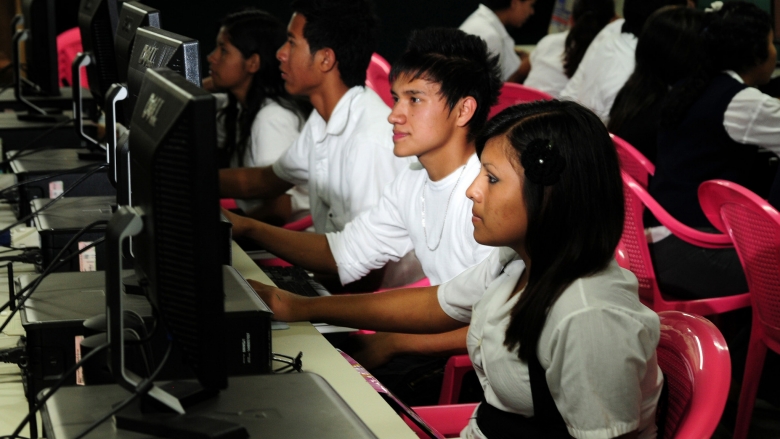Challenge
As of 2007, access to a LSE in Guatemala was an important development challenge. Nationally, only about 40 percent of students began LSE, and less than three-quarters of those reached the final year. Differences between indigenous and non-indigenous student populations in LSE access were stark: whereas non-indigenous student populations showed a 74 percent gross enrollment rate (GER) for LSE, indigenous student populations presented a 26 percent rate. Public secondary education provision was limited, and private institutions served over 70 percent of secondary students. Although girls attended LSE at similar rates as boys, geographic access was a clear issue: urban students were 40 percent more likely to enter secondary school than rural students. Approximately 30 percent of children were expected to complete lower secondary, and only 23 percent would enroll in upper secondary.
Approach
EQSEP approached the development challenge mentioned above through two key approaches: (i) a targeting mechanism to boost coverage in municipalities with the highest levels of disadvantage; and (ii) financial support for specific LSE modalities (called “flexible”) that could be the most realistic to enhance access.
The choice of flexible modalities was an innovative strategy to maximize access to LSE in a cost-effective way (i.e. without having to invest massive amounts of money into infrastructure or hiring 7th-through-9th-grade teachers). TIs were LSE modalities that used audiovisual pedagogical material to cover 7th-9th grade subjects and one facilitator (teacher) per grade.
Funding from the Project financed a combination of interventions (payment of facilitators’ salaries; new equipment and furniture; and pedagogical material) to support TIs. In the midst of a serious fiscal crisis faced by the country, the Project flexibly adapted to support the temporary payment of facilitators’ salaries, which helped keep the momentum.
Results
The Project’s most significant achievement in terms of LSE coverage, from Project approval in 2007 to Project closure in 2015, was two-fold:
(i) a 174 percent increase (from 39,916 in 2007) in the number of students attending LSE in TIs nationwide; and
(ii) a 32 percent increase in the GER for LSE for targeted municipalities (from a 42 percent rate in 2007to a 51 percent rate in 2015).
The results chain behind this significant result (outcome) was the following:
a) Main inputs financed:
· Monthly salaries for a total of 5,893 TI facilitators’ financed temporarily from 2009 through 2012.
· Information and Communications Technology (ICT) equipment combos – computers, printers, projectors, hard disks, and USBs - distributed to all 1,673 TIs from 2009 through 2012.
· Furniture combos – blackboards, student desks, teacher desks, bookshelves - distributed to all 1,673 TIs from 2009 through 2012.
· Pedagogical material for teachers and students, including intercultural bilingual material and books from the National Reading Program, distributed to all 1,673 TIs from 2009 through 2014.
· Teacher training workshops delivered to all 4,133 TIs facilitators from 2009 through 2012.
b) Main output obtained:
· Thoroughly revised TI pedagogical material for grades 7, 8, and 9 fully aligned to the National Basic Curriculum (NBC) for Guatemala (pre-existing material had been imported from Mexico and was neither aligned to the NBC or contextualized to the Guatemalan reality)
Bank Group Contribution
The World Bank provided a loan of US$80 million toward the total project cost of US$100 million. These funds were used to help pay for teacher salaries, training workshops, school equipment, and learning materials.
Partners
The EQSEP did not have any specific external Project partner. However, some donors also supported efforts spearheaded by the EQSEP. For example, the German Cooperation, through GIZ - its analytical arm – financed a few studies documenting how improved access-related outcomes at the LSE level were improving access-related indicators at the upper secondary education level. The main national Project partner was the Ministry of Education, where the Project Implementation Unit was located throughout the lifetime of the Project.
Moving Forward
The EQSEP helped support a significant access-related intervention for expanding LSE in Guatemala. TIs are now viewed as a good first step to expand LSE access in low-income settings. However, this particular intervention seems to be limited by size. In fact, in 2016, 40 TIs have been converted to regular LSE schools (known as Institutos Nacionales de Educación Básica or INEBs) due to the significant enrollment numbers they reached over time. In other words, the sustainability of the TI model can be guaranteed up to a certain threshold after which a more significant financial effort (e.g. hiring a larger number of teachers) become a must.
Beneficiaries
The EQSEP, and specifically the financial support to TIs, had a significant impact, especially on the indigenous population. For example, nationwide, the proportion of indigenous students enrolled in LSE increased 25 percent, from 2007 through 2014. Whereas the number of indigenous students enrolled in LSE in 2007 was around 120,000 (roughly 20.5 percent of the total LSE student population), this number grew to roughly 200,000 as of 2015 (representing now 25.2 of the total LSE student population).
Last Updated: Oct 13, 2016

